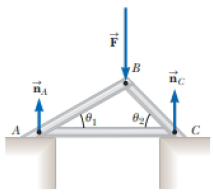
Concept explainers
Figure P12.38 shows a light truss formed from three struts lying in a plane and joined by three smooth hinge pins at their ends. The truss supports a downward force of
Figure P12.38

Trending nowThis is a popular solution!

Chapter 12 Solutions
Physics for Scientists and Engineers
- Consider a nanotube with a Youngs modulus of 2.130 1012 N/m2 that experiences a tensile stress of 5.3 1010 N/m2. Steel has a Youngs modulus of about 2.000 1011 Pa. How much stress would cause a piece of steel to experience the same strain as the nanotube?arrow_forwardWhy is the following situation impossible? A worker in a factory pulls a cabinet across the floor using a rope as shown in Figure P12.36a. The rope make an angle = 37.0 with the floor and is tied h1 = 10.0 cm from the bottom of the cabinet. The uniform rectangular cabinet has height = 100 cm and width w = 60.0 cm, and it weighs 400 N. The cabinet slides with constant speed when a force F = 300 N is applied through the rope. The worker tires of walking backward. He fastens the rope to a point on the cabinet h2 = 65.0 cm off the floor and lays the rope over his shoulder so that he can walk forward and pull as shown in Figure P12.36b. In this way, the rope again makes an angle of = 37.0 with the horizontal and again has a tension of 300 N. Using this technique, the worker is able to slide the cabinet over a long distance on the floor without tiring. Figure P12.36 Problems 36 and 44.arrow_forwardA uniform wire (Y = 2.0 1011 N/m2) is subjected to a longitudinal tensile stress of 4.0 107 N/m2. What is the fractional change in the length of the wire?arrow_forward
- Hello Bartleby , i need to solve this question quickly i have a testarrow_forwardÁ brass wire (Y = 10" N/m²) and a steel %3D wire (Y = 2 x 10" N/m²) of equal length and diameter are suspended from a common rigid support. The free ends A of brass and B of steel at a distance of 75 cm are connected by a %3D horizontal bar, with both the wires vertical and parallel. Calculate the distance of a point from B, at which a load may be attached so that the bar remains horizontal. 75cm (75-x) P,arrow_forwardThe leg bone (femur) breaks under a compressive force of about 7.90 × 104 N for a human and 11.3 × 104 N for a horse. The human femur has a compressive strength of 160 MPa, whereas the horse femur has a compressive strength of 140 MPa. What is the effective cross-sectional area of the femur in a horse? (Note: Since the center of the femur contains bone marrow, which has essentially no compressive strength, the effective cross-sectional area is about 80% of the total cross-sectional area.)arrow_forward
- Ea- d ms A horizontal L=1.4 m long mb3D12kg uniform bar is hinged on the left end and pulled at the right end by a cable. The cable makes 30° angle with horizontal. A 22 kg store sign is suspended below the bar at d=0.18 m from the right end. Find the magnitude of horizontal hinge force.arrow_forwardThe truss is made of three A-36 steel members, each having a cross-sectional area of 400 mm2. Determine the magnitude P required to displace the roller to the right 0.2 mm.arrow_forwardA cylindrical steel wire that is 2 m long must stretch no more than 0.25 cm when the applied tensile force is 700 N to each end of the wire. Find the minimum cross-sectional radius that is required for the wire if the Ysteel is 20 x 1010 Pa. Choices in the image.arrow_forward
- As shows a light truss formed from three struts lying in a plane and joined by three smooth hinge pins at their ends. The truss supports a downward force of F→ = 1 000 N applied at the point B. The truss has negligible weight. The piers at A and C are smooth. (a) Given θ1 = 30.0° and θ2 = 45.0°, find nA and nC. (b) One can show that the force any strut exerts on a pin must be directed along the length of the strut as a force of tension or compression. Use that fact to identify the directions of the forces that the struts exert on the pins joining them. Find the force of tension or of compression in each of the three bars.arrow_forwardA uniform rod is attached to a wall by a hinge at its base. The rod has a mass of 3.5 kg, a length of 1.3 m, is at an angle of 31° above the horizontal, and is held in place by a horizontal cord attached to the other end of the rod and bolted to the wall above the base of the rod. (a) Determine the tension in the cord. N (b) Determine the horizontal and vertical components of the force exerted on the rod by the hinge. N FH Fv Narrow_forwardA bar ACB has is subjected to an external load at C, and it is supported either end by a cable as shown in fig. below. Calculate the smallest area of each cable if the stress is not to exceed 90 MPa in bronze and 120 MPa in steel. Bronze 5m Steel 3 m 4 m C 8m B 12m 10 KNarrow_forward
 Physics for Scientists and EngineersPhysicsISBN:9781337553278Author:Raymond A. Serway, John W. JewettPublisher:Cengage Learning
Physics for Scientists and EngineersPhysicsISBN:9781337553278Author:Raymond A. Serway, John W. JewettPublisher:Cengage Learning Physics for Scientists and Engineers with Modern ...PhysicsISBN:9781337553292Author:Raymond A. Serway, John W. JewettPublisher:Cengage Learning
Physics for Scientists and Engineers with Modern ...PhysicsISBN:9781337553292Author:Raymond A. Serway, John W. JewettPublisher:Cengage Learning Physics for Scientists and Engineers: Foundations...PhysicsISBN:9781133939146Author:Katz, Debora M.Publisher:Cengage Learning
Physics for Scientists and Engineers: Foundations...PhysicsISBN:9781133939146Author:Katz, Debora M.Publisher:Cengage Learning


